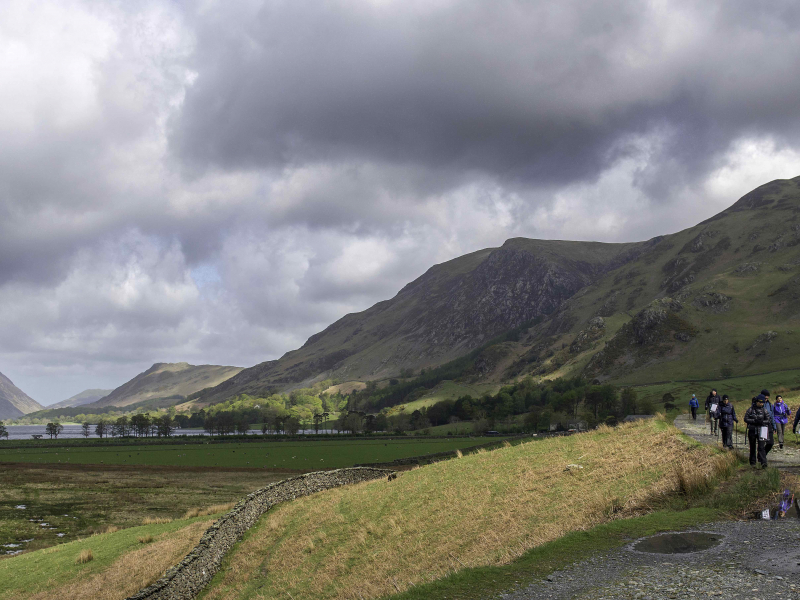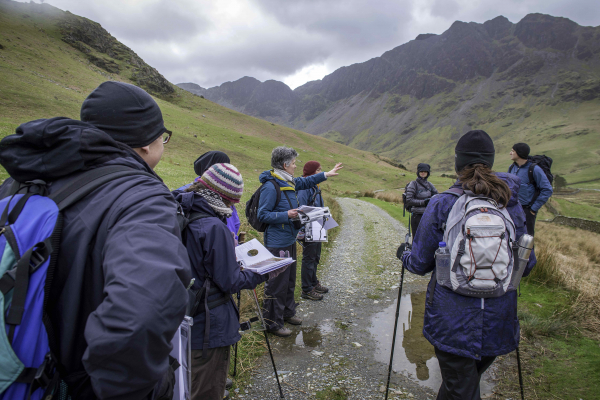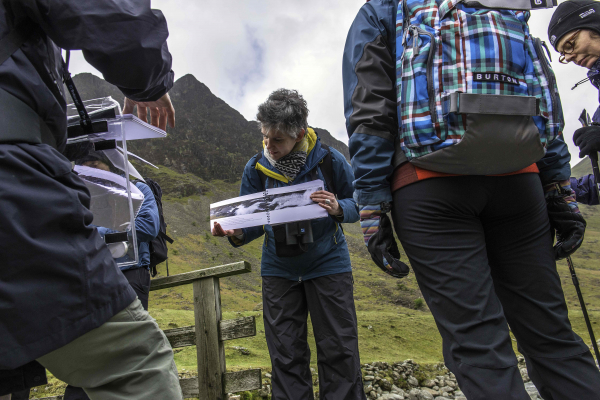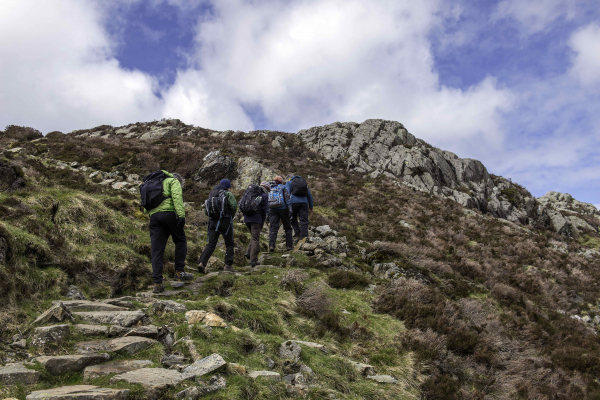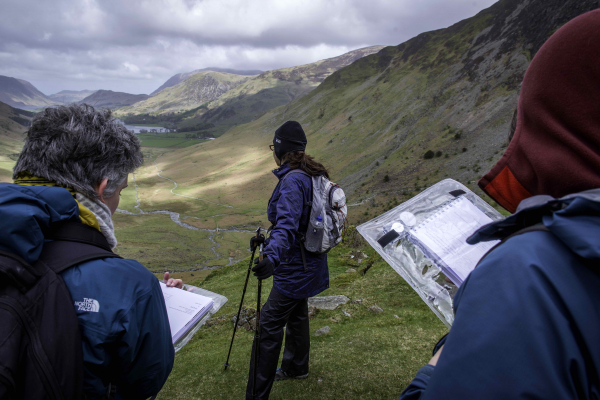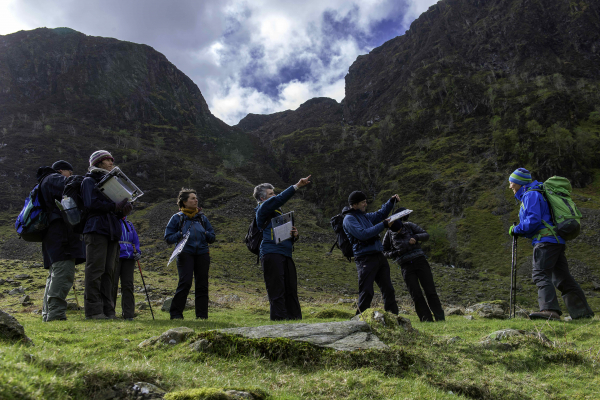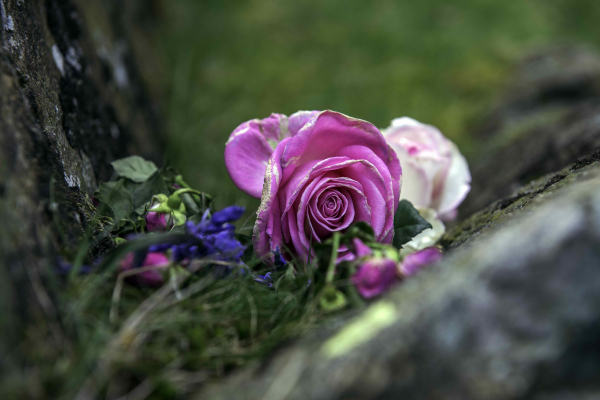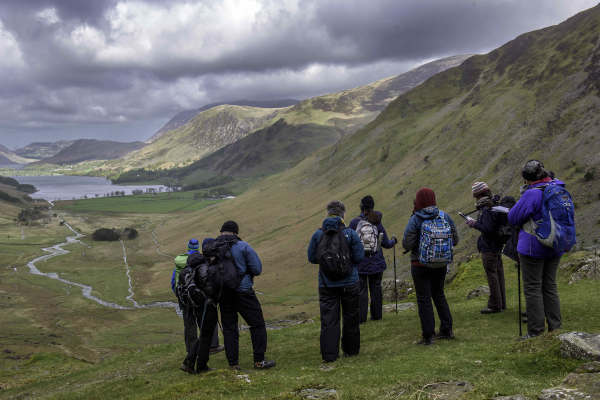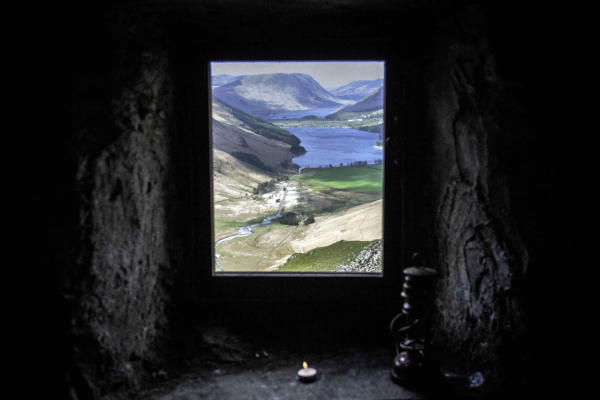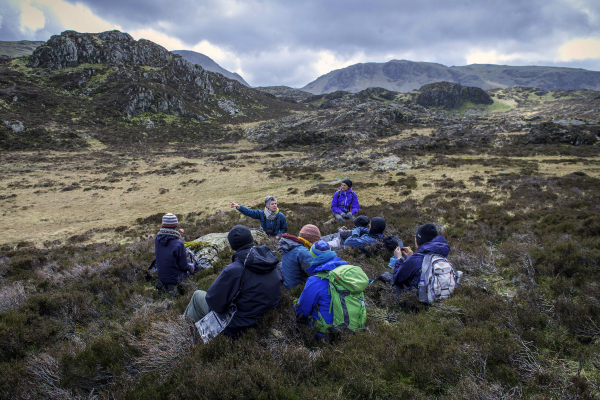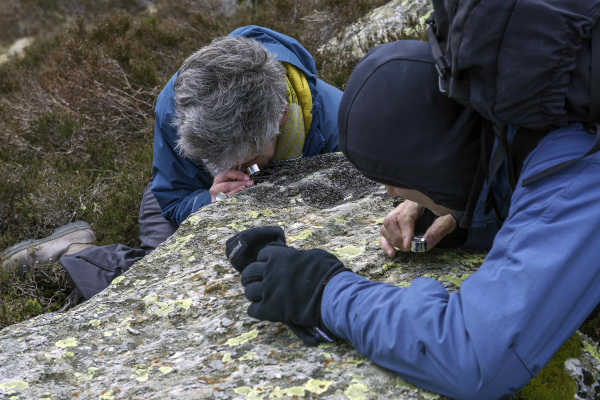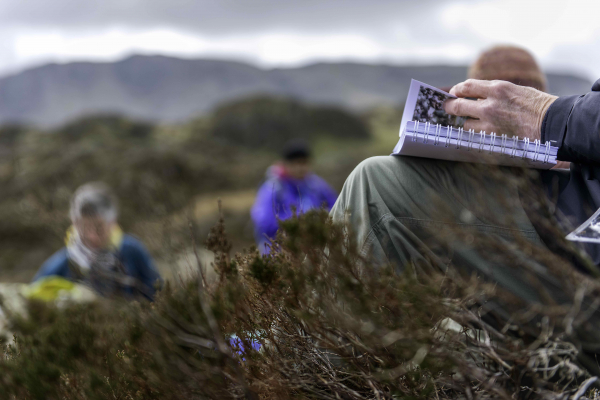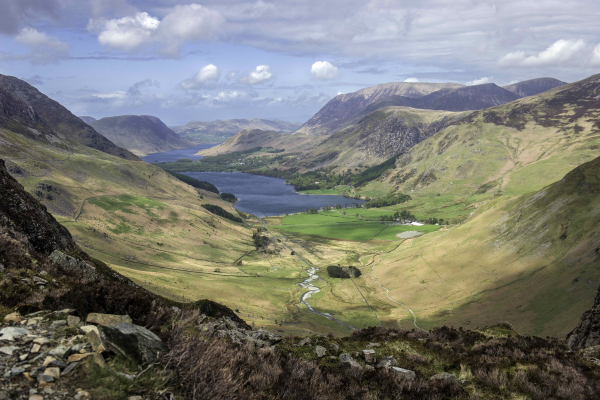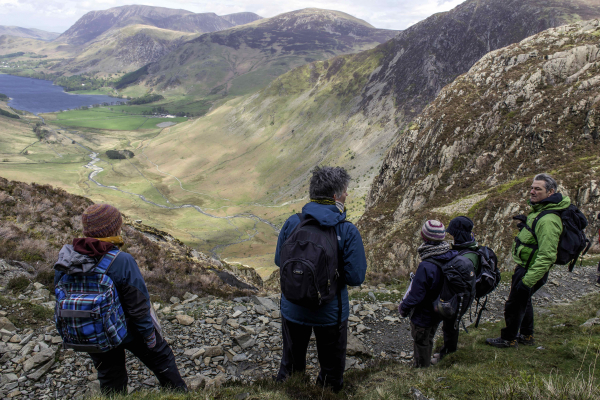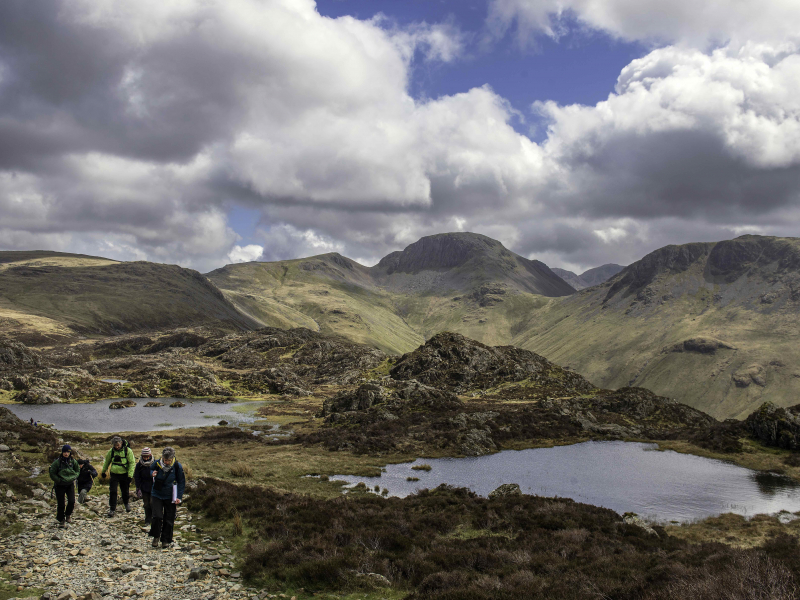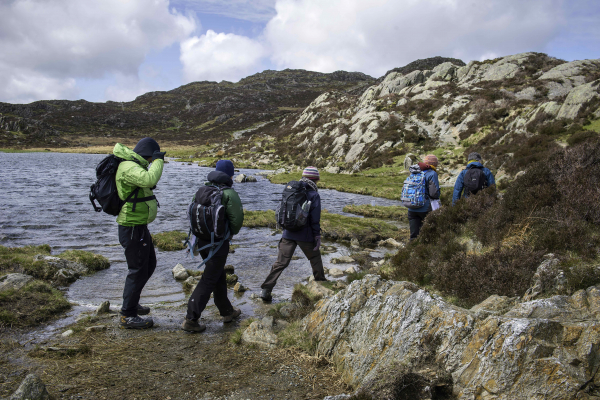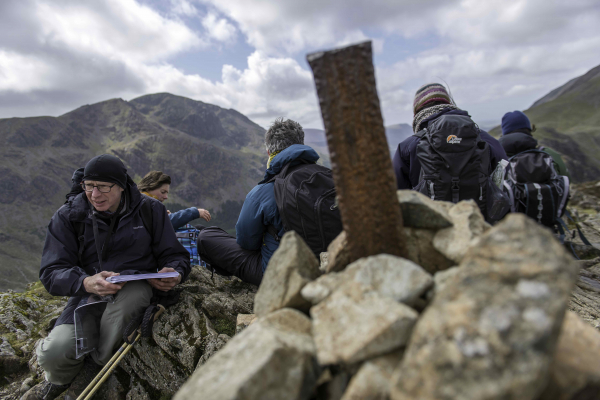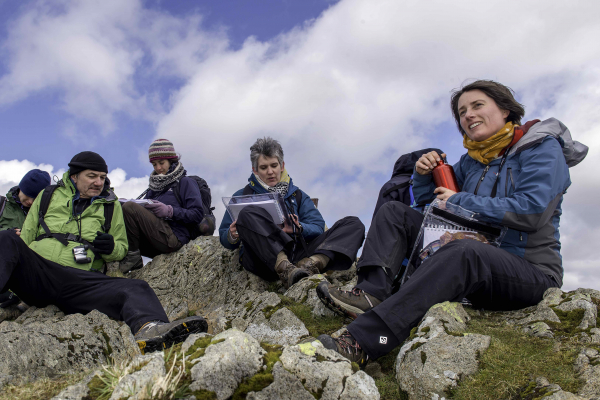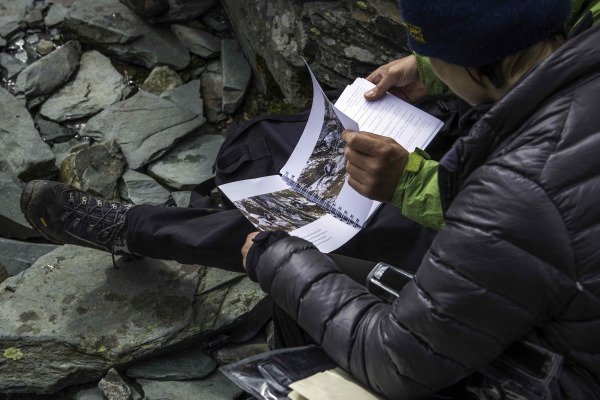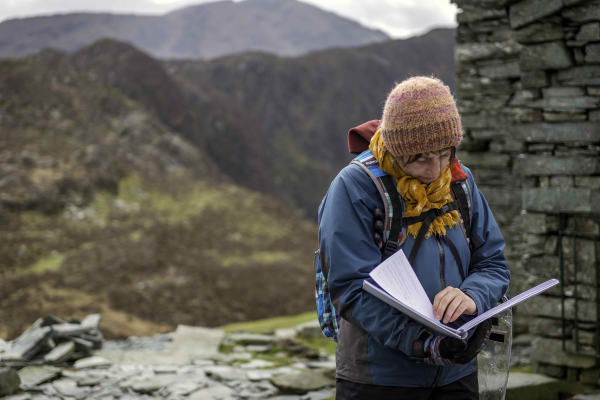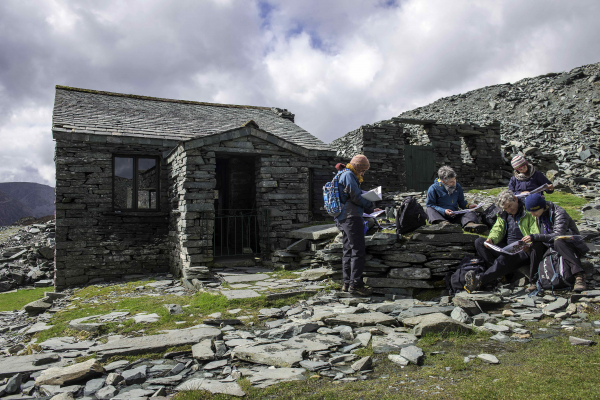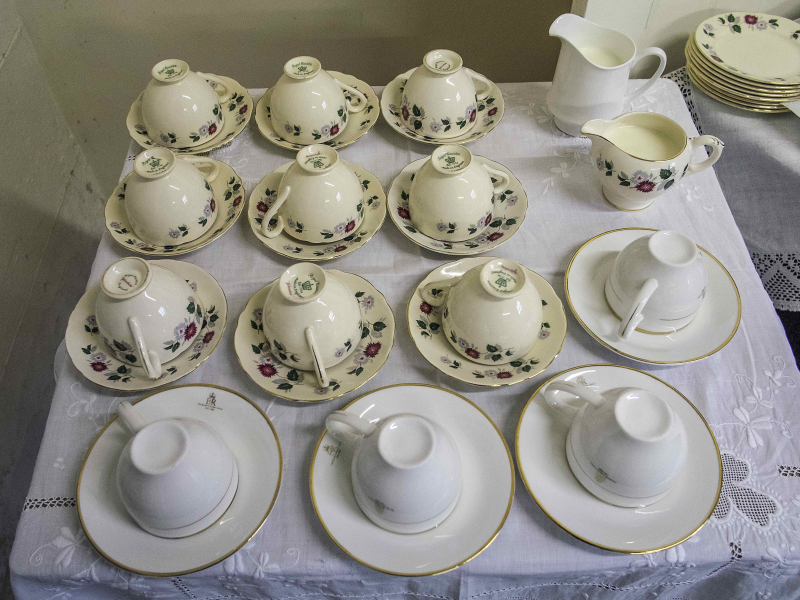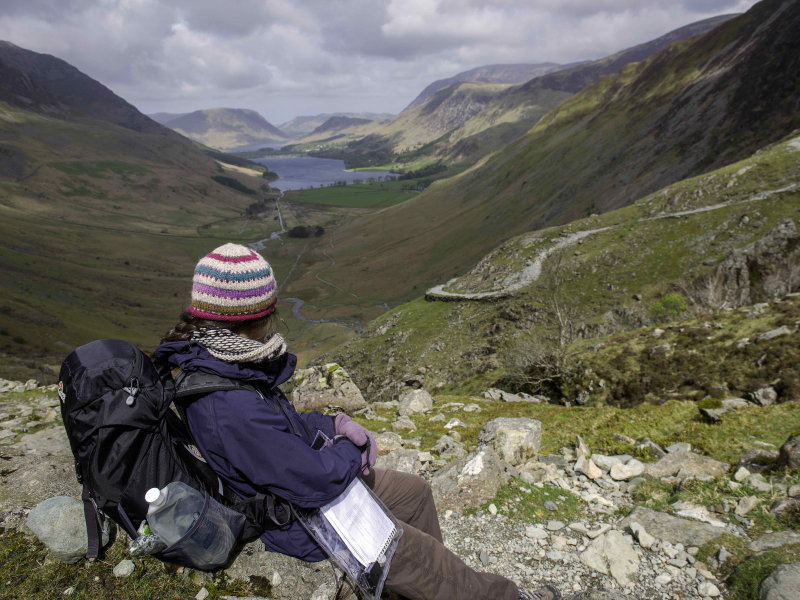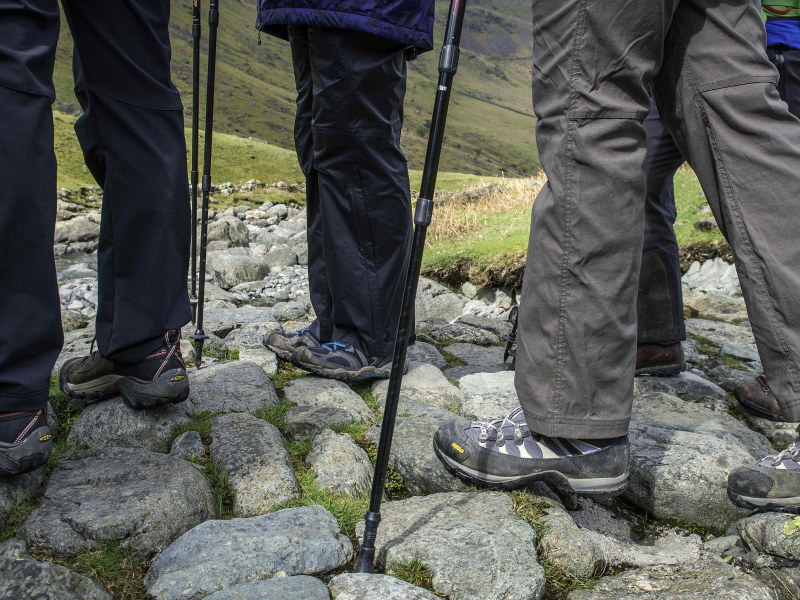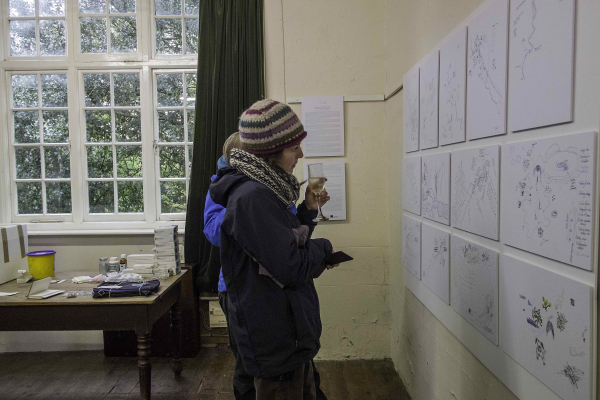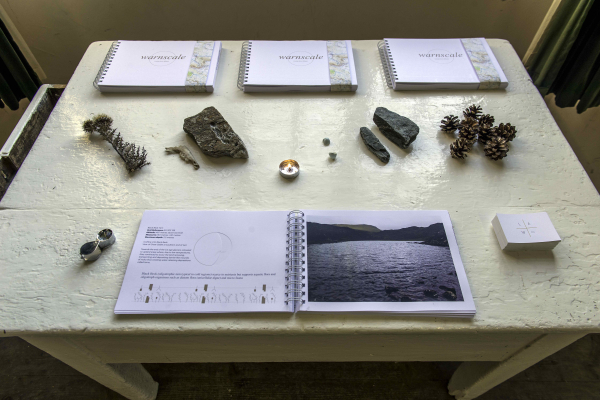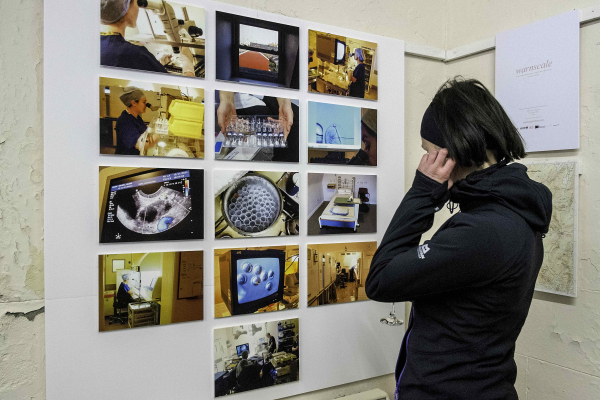Warnscale: A Land Mark Walk Reflecting on In/Fertility and Childlessness
_1000_500_s_c1_c_c.JPG)
Warnscale: A Land Mark Walk Reflecting on In/Fertility and Childlessness
16-17 May 2015 (ongoing through published book), Warnscale Fells, Buttermere
Warnscale: A Land Mark Walk Reflecting on In/Fertility and Childlessness (Warnscale) is a self-guided walk specific to, and created in, Warnscale, an area of fells to the south of Buttermere Lake, Cumbria. The performance is mediated through a walking guide and art book and is aimed at women who are childless-by-circumstance.
Society offers no rituals or rites of passage through which women who have 'missed' the life-event of biological motherhood can be acknowledged and can come to terms with that absence. This walking performance, however, offers imaginative and creative ways through which women can engage with landscape to reflect upon and even transform their experience of this circumstance. The book through which it is experienced provides a multilayered yet non-prescriptive means for the walker — whether walking alone, with a partner, friend or in a group — to make and perform their own journey, and can also be used by others who are in sympathy with women in this circumstance and persons in comparable situations.
Louise developed Warnscale through research that involved a series of group and one to one mapping-walks with women who are childless-by-circumstance, residencies at fertility clinics, in-depth study of the landscape, conversations with people with local knowledge and studying the journals of Dorothy Wordsworth, who walked in and wrote extensively about her visual and em-bodied experience of the landscape of the Lake District.
The book combines a guide to the walk and the landscape with original drawings and photographs by Louise, the words of Dorothy Wordsworth, written and visual reflections on infertility and invitations to immerse oneself in the landscape in different ways designed to encourage contemplation of one’s own life experience. It is an artist’s book which is also a many layered guide book.
The limited edition book (with geology hand lens) is available to order at a subsidised price of £23 (plus P&P) here. Groups and individuals can undertake the walk in their own time.
Written and Designed by Louise Ann Wilson.
Published by Louise Ann Wilson Company Limited. ISBN: 978-0-9932664-0-9
Printed by Bowmans, Leeds. Digital Layout by Gareth Dennison, Morph Films, Lancaster.
Project Produced by Peter Reed and Louise Ann Wilson
Mapping-Walk Participants (identified by initials): AD, RG, RGi, PG,
Project Advisors – Fertility and Social Science: Joyce Harper, Institute for Women's Health, UCL; Celia Roberts, College of Arts and Social Sciences, Australia National University (formerly Senior Lecturer in Centre for Gender and Women's Studies at Lancaster University; Jody Day, Gateway Women; Wanda Georgiades and the CARE Fertility Group; the embryology team, The Centre for Reproductive & Genetic Health, London; the archivists at the Wellcome Trust.
Project Advisors – Landscape, Literary and Local: Mr Richardson, Gatesgarth Farm; Honister Slate Quarry; Barbara Ibberson, Old School House, Buttermere; The Museum of Lakeland Life & Industry; Mike Kelly, Geologist; Mark Astley, National Trust; Jean Johnston, Natural England; Denis Mollison and the Mountain Bothies Association; Helen Turton, Mountain Leader. The Armitt Museum; Jeff Cowton and the archivist at The Wordsworth Trust; Andrew Stuck of Talking Walking; John Rodwell; Andy Edwards; Simon Bainbridge, English and Creative Writing, Lancaster University.
PhD Supervisors: Geraldine Harris and Andrew Quick, Lancaster Institute for the Contemporary Arts, Lancaster University.
Funded by Arts Council England, Arts & Humanities Research Council, Seedbed Trust.
Supported by Lancaster Institute for the Contemporary Arts, Lancaster University.
Author and Designer: Louise Ann Wilson.
Publishers: Louise Ann Wilson Company Limited.
ISBN: 978-0-9932664-0-9
With thanks to:
The mapping-walk participants.
Joyce Harper, Institute for Women's Health, UCL; Celia Roberts, Department of Sociology, Lancaster University; Jody Day, Gateway Women; Wanda Georgiades and the CARE Fertility Group; the embryology team, The Centre for Reproductive & Genetic Health, London; the archivists at the Wellcome Trust.
Mr Richardson, Gatesgarth Farm; Honister Slate Quarry; Barbara Ibberson, Old School House, Buttermere; The Museum of Lakeland Life & Industry; Mike Kelly, Geologist; Mark Astley, National Trust; Jean Johnston, Natural England; Denis Mollison and the Mountain Bothies Association; Helen Turton, Mountain Leader.
The Armitt Museum; Jeff Cowton and the archivist at The Wordsworth Trust; Andrew Stuck of Talking Walking; John Rodwell; Andy Edwards; Simon Bainbridge; Geraldine Harris and Andrew Quick, LICA, Lancaster University.
The Directors of Louise Ann Wilson Company Ltd (Linda Broughton, David Honeybone and Derek Tarr) and Peter Reed, Producer for the company.
Book Printers: Bowmans, Leeds.
Digital Layout: Gareth Dennison, Morph Films, Lancaster.
The project and publication has been made possible using public funding by Arts Council England; grants from the Arts & Humanities Research Council and Seedbed Trust; and support from Lancaster Institute for the Contemporary Arts, Lancaster University.
Whilst working on The Gathering (2014) Louise was struck forcibly by how shepherds used the word ‘empty’ to describe a ewe that has not become pregnant before being ‘turned up’ to the mountain. In Cumbria, such ewes are called ‘gelds’. Warnscale explores how walking and landscape can be harnessed to create new metaphors for the experience of childlessness and thus make possible futures that are rich in significance – it seeks to ‘fill the empty’.
For the location of Warnscale, Louise decided to look for an empty room on a mountain, ‘a place’, writes Graham Usher, ‘traditionally associated with revelation, transition or inspiration’. She soon discovered Warnscale Head Bothy. Knowing that the performance and book would pivot around this location, she went on to research and develop it through in-depth study of the landscape in which it is situated, and conversations with people with local knowledge of the place. This research was combined with observational research in fertility clinics, and a close reading of the journal writings of Dorothy Wordsworth who walked in and wrote extensively about her experience of the landscape of the Lake District.
Whilst working on The Gathering (2014) Louise was struck forcibly by how shepherds used the word ‘empty’ to describe a ewe that has not become pregnant before being ‘turned up’ to the mountain. In Cumbria, such ewes are called ‘gelds’. Warnscale explores how walking and landscape can be harnessed to create new metaphors for the experience of childlessness and thus make possible futures that are rich in significance – it seeks to ‘fill the empty’.
For the location of Warnscale, Louise decided to look for an empty room on a mountain, ‘a place’, writes Graham Usher, ‘traditionally associated with revelation, transition or inspiration’. She soon discovered Warnscale Head Bothy. Knowing that the performance and book would pivot around this location, she went on to research and develop it through in-depth study of the landscape in which it is situated, and conversations with people with local knowledge of the place. This research was combined with observational research in fertility clinics, and a close reading of the journal writings of Dorothy Wordsworth who walked in and wrote extensively about her experience of the landscape of the Lake District.
At the little foot-Bridge we stopped to look at the company of rivers which came hurrying down the vale this way & that; it was a valley of streams & Islands, with that great waterfall at the head and lesser falls in different parts of the mountains coming down these Rivers. We walked forward & backwards until all distant objects except the white shape of the waterfall, & the lines of the mountain were gone.
Dorothy Wordsworth, Grasmere Journal, 9 December 1800.
How do you come to terms with the acutely felt loss of something that has never been?...the lost hope of a child...an unconceived child where instead of a person an empty space presents itself.
Naomi Cumming, Grief Unconceived.
At the little foot-Bridge we stopped to look at the company of rivers which came hurrying down the vale this way & that; it was a valley of streams & Islands, with that great waterfall at the head and lesser falls in different parts of the mountains coming down these Rivers. We walked forward & backwards until all distant objects except the white shape of the waterfall, & the lines of the mountain were gone.
Dorothy Wordsworth, Grasmere Journal, 9 December 1800.
How do you come to terms with the acutely felt loss of something that has never been?...the lost hope of a child...an unconceived child where instead of a person an empty space presents itself.
Naomi Cumming, Grief Unconceived.
end of path...family line stops
regret...looking back...missed opportunities
hysterectomy...sudden decision...remove possibility
Dorothy Wordsworth...writing...many generations
many grandmothers...trees dying out
beautiful...autumnal...love this spot...sit...be quiet
a grotto...calm...settled
feeling better...hope for future...whatever it is
different futures...identity...new self
land returning
puddle...frogs eggs...huge compared to human eggs
stillness
Extract of words distilled from 'mapping walks'.
end of path...family line stops
regret...looking back...missed opportunities
hysterectomy...sudden decision...remove possibility
Dorothy Wordsworth...writing...many generations
many grandmothers...trees dying out
beautiful...autumnal...love this spot...sit...be quiet
a grotto...calm...settled
feeling better...hope for future...whatever it is
different futures...identity...new self
land returning
puddle...frogs eggs...huge compared to human eggs
stillness
Extract of words distilled from 'mapping walks'.
The on-site landscape research was combined with observational research in fertility clinics.
The on-site landscape research was combined with observational research in fertility clinics.
IVF eliminates the natural cycle re-placing it with an artificial one that controls biology. At times it is experienced as the 'quest for a miracle baby' that is not just a strictly biological or technical journey, but a spiritual one of faith, hope, and sacrifice.
Sarah Franklin, Born and Made.
IVF eliminates the natural cycle re-placing it with an artificial one that controls biology. At times it is experienced as the 'quest for a miracle baby' that is not just a strictly biological or technical journey, but a spiritual one of faith, hope, and sacrifice.
Sarah Franklin, Born and Made.
I have just opened your beautiful book - it is stunning. I have never seen the subject of infertility demonstrated in such a moving and graphic way.
...We focus so much on achieving “success” having that much wanted child, beating the odds to become parents through IVF. We probably don’t acknowledge adequately the number of patients who will not have a baby this way – ever. This project shows in a graphic form how different people cope with the loss of the baby they may never have, the grief for something that will never be. It is a beautifully executed book pulling together strands of treatment into strands of landscape. Thought provoking and moving.
Wanda Georgiades, CARE Fertility Group.
I have just opened your beautiful book - it is stunning. I have never seen the subject of infertility demonstrated in such a moving and graphic way.
...We focus so much on achieving “success” having that much wanted child, beating the odds to become parents through IVF. We probably don’t acknowledge adequately the number of patients who will not have a baby this way – ever. This project shows in a graphic form how different people cope with the loss of the baby they may never have, the grief for something that will never be. It is a beautifully executed book pulling together strands of treatment into strands of landscape. Thought provoking and moving.
Wanda Georgiades, CARE Fertility Group.
Warnscale was developed through a series of mapping-walks with women who are biologically childless-by-circumstance. The women who took part were biolgocially childless for a range of reasons including biological or medical factors, age-related or undiagnosed infertility; or social infertility factors, such as the absence of a relationship or a relationship with a person who does not want, or is uanble to have, children. A number had and/or were continuing to have infertility treatment, whilst others had decided to stop pursuing treatment after multiple attempts, and were seeking pregnancy through donor eggs, had adopted children or were deciding to adopt, or were unresolved as to what to do next.
Many of the women talked about the isolation that infertility and fertility treatment causes and their grief for the biological children they will not bear; some had realised too late that their fertility window was limited and time was running, or had run, out. Often there was the feeling that their lack of childbearing was disappointing for parents and grandparents, and the weight of that awareness was increased by the knowledge that their family line could end with them; many were reconsidering what their identity would be outside of biological motherhood.
Warnscale was developed through a series of mapping-walks with women who are biologically childless-by-circumstance. The women who took part were biolgocially childless for a range of reasons including biological or medical factors, age-related or undiagnosed infertility; or social infertility factors, such as the absence of a relationship or a relationship with a person who does not want, or is uanble to have, children. A number had and/or were continuing to have infertility treatment, whilst others had decided to stop pursuing treatment after multiple attempts, and were seeking pregnancy through donor eggs, had adopted children or were deciding to adopt, or were unresolved as to what to do next.
Many of the women talked about the isolation that infertility and fertility treatment causes and their grief for the biological children they will not bear; some had realised too late that their fertility window was limited and time was running, or had run, out. Often there was the feeling that their lack of childbearing was disappointing for parents and grandparents, and the weight of that awareness was increased by the knowledge that their family line could end with them; many were reconsidering what their identity would be outside of biological motherhood.
I loved the walk itself, and all its weather. I really liked making the map at the end. I was glad of the opportunity to talk with other women along the way [...] The book is a very beautiful reminder of the walk, but also feels like a deeper resource for thinking about land, children, belonging.
A thoroughly unique and welcome experience that blended the artistic, somatic and personal in one of nature’s beautiful settings, allowing connection to ourselves, the landscape and our point in time.
There's a line in a John Grant song about a landscape being carved by the glacias moving through it - carving deep valleys and enriching the soil with minerals the pain of childlessness felt something like that – it had a depth I have never experienced
before.
Mapping-Walk Participants
I loved the walk itself, and all its weather. I really liked making the map at the end. I was glad of the opportunity to talk with other women along the way [...] The book is a very beautiful reminder of the walk, but also feels like a deeper resource for thinking about land, children, belonging.
A thoroughly unique and welcome experience that blended the artistic, somatic and personal in one of nature’s beautiful settings, allowing connection to ourselves, the landscape and our point in time.
There's a line in a John Grant song about a landscape being carved by the glacias moving through it - carving deep valleys and enriching the soil with minerals the pain of childlessness felt something like that – it had a depth I have never experienced
before.
Mapping-Walk Participants
The mapping-walks took place over a year and were undertaken in all weathers as one-to-one walks or in a small group. Each walk invited participants to respond to the landscape and environmental phenomenon of the place, and to notice sights and sounds, thus allowing the landscape, and its changing forces, to become a metaphor for each participant’s personal experiences of childlessness. After the mapping-walk, participants drew a memory map of their walk that highlighted places or moments of significance and meaning. It is these mapping-walks, maps and the words, and the feelings, images and conversations they provoked, that Louise distilled into one map and, with the other research materials, developed into the book.
The mapping-walks took place over a year and were undertaken in all weathers as one-to-one walks or in a small group. Each walk invited participants to respond to the landscape and environmental phenomenon of the place, and to notice sights and sounds, thus allowing the landscape, and its changing forces, to become a metaphor for each participant’s personal experiences of childlessness. After the mapping-walk, participants drew a memory map of their walk that highlighted places or moments of significance and meaning. It is these mapping-walks, maps and the words, and the feelings, images and conversations they provoked, that Louise distilled into one map and, with the other research materials, developed into the book.
blackthorn...hawthorn...buds...starting to open...embryos
three...four...IVF...trapped in cycle
too much science...things not working out
disappointment...grandparents...parents
LOSS
juniper...birdsong...still air
tree...roots and branches
family tree...mother...grandmother...daughter
words...thoughts...stories...talk...stones...tumbling
Extract of words distilled from 'mapping walks'.
blackthorn...hawthorn...buds...starting to open...embryos
three...four...IVF...trapped in cycle
too much science...things not working out
disappointment...grandparents...parents
LOSS
juniper...birdsong...still air
tree...roots and branches
family tree...mother...grandmother...daughter
words...thoughts...stories...talk...stones...tumbling
Extract of words distilled from 'mapping walks'.
Ways of looking are central to the development and design of this performance and book which has been greatly inspired by two ways of perceiving landscape, namely, the picturesque (Warnscale Head Bothy has a window that frames the expansive view of the valley) and, secondly, the feminine sublime, both of which are embodied in the writing of Dorothy Wordsworth. The research on site and in fertility clinics revealed different sorts and scales of looking. A geological lens reveals the detail of a volcanic rock and the lichen growing on it. Binoculars bring the distant landscape closer. Microscopes enable the study of micro fauna in a tarn; the grading of human oocytes, sperm and embryos in a womb; and observation of the womb lining prepearing itself for the implantation of an oocyte then emptying itself when it has not. What these ways of looking do not reveal is the longing for a child.
Warnscale seeks to help the walker find a place for quiet reflection and experience the elemental forces around and within, share their own story, acknowledge where they are at present and consider the future paths they might follow, express the worries and fears that otherwise they may not dare to think, or speak and find new ways of seeing that may lead to new ways of feeling. The hope is that the performance and book enables a participant to enter into this landscape as a place of metaphor and reflection and, like Dorothy Wordsworth, that, through walking, they connect to place and in so doing connect to themselves in such a way that might be transformative.
Ways of looking are central to the development and design of this performance and book which has been greatly inspired by two ways of perceiving landscape, namely, the picturesque (Warnscale Head Bothy has a window that frames the expansive view of the valley) and, secondly, the feminine sublime, both of which are embodied in the writing of Dorothy Wordsworth. The research on site and in fertility clinics revealed different sorts and scales of looking. A geological lens reveals the detail of a volcanic rock and the lichen growing on it. Binoculars bring the distant landscape closer. Microscopes enable the study of micro fauna in a tarn; the grading of human oocytes, sperm and embryos in a womb; and observation of the womb lining prepearing itself for the implantation of an oocyte then emptying itself when it has not. What these ways of looking do not reveal is the longing for a child.
Warnscale seeks to help the walker find a place for quiet reflection and experience the elemental forces around and within, share their own story, acknowledge where they are at present and consider the future paths they might follow, express the worries and fears that otherwise they may not dare to think, or speak and find new ways of seeing that may lead to new ways of feeling. The hope is that the performance and book enables a participant to enter into this landscape as a place of metaphor and reflection and, like Dorothy Wordsworth, that, through walking, they connect to place and in so doing connect to themselves in such a way that might be transformative.
All the while I was guided by the words of Dorothy Wordsworth and Louise Ann Wilson. Dorothy made me look at the landscape – the shapes, colours, sounds – how often she describes something so perfectly. Louise spoke to me in other ways – inviting me to stop, listen, feel, experience; encouraging me to consider the smallest details of life, from a perspective not simply my own. In these mountains we can find ‘the bliss of solitude’. There were other voices too: those of women ‘childless through circumstance’.
Jeff Cowton, Curator and Director of The Wordsworth Trust.
All the while I was guided by the words of Dorothy Wordsworth and Louise Ann Wilson. Dorothy made me look at the landscape – the shapes, colours, sounds – how often she describes something so perfectly. Louise spoke to me in other ways – inviting me to stop, listen, feel, experience; encouraging me to consider the smallest details of life, from a perspective not simply my own. In these mountains we can find ‘the bliss of solitude’. There were other voices too: those of women ‘childless through circumstance’.
Jeff Cowton, Curator and Director of The Wordsworth Trust.
Gallery
Warnscale Book Launch Walks & Exhibition 16 & 17 May 2015
Warnscale Book Launch Walks & Exhibition 16 & 17 May 2015
Every tooth & every edge of Rock was visible [...] like a Giant watching from the Roof of a lofty Castle. The hill seemed perpendicular from the darkness below it.
Dorothy Wordsworth, Grasmere Journal, 24 November 1800.
The sykes made a sweet sound everywhere. The little one was very impressive, a ghostly white serpent line – it made a sound most distinctly heard of itself.
Dorothy Wordsworth, Grasmere Journal, 22 February 1802.
Every tooth & every edge of Rock was visible [...] like a Giant watching from the Roof of a lofty Castle. The hill seemed perpendicular from the darkness below it.
Dorothy Wordsworth, Grasmere Journal, 24 November 1800.
The sykes made a sweet sound everywhere. The little one was very impressive, a ghostly white serpent line – it made a sound most distinctly heard of itself.
Dorothy Wordsworth, Grasmere Journal, 22 February 1802.
It is a glorious wild solitude under that lofty purple crag. It stood upright by itself. Its own self & its shadow below, one mass – all else was sunshine.
Dorothy Wordsworth, Grasmere Journal, 4 May 1802.
Walked to the top of a high hill...again sate down to feed upon the prospect; a magnificent scene, curiously spread out for even minute inspection, though so extensive that the mind is afraid to calculate its bounds.
Dorothy Wordsworth, Alfoxden Journal, February 1798.
It is a glorious wild solitude under that lofty purple crag. It stood upright by itself. Its own self & its shadow below, one mass – all else was sunshine.
Dorothy Wordsworth, Grasmere Journal, 4 May 1802.
Walked to the top of a high hill...again sate down to feed upon the prospect; a magnificent scene, curiously spread out for even minute inspection, though so extensive that the mind is afraid to calculate its bounds.
Dorothy Wordsworth, Alfoxden Journal, February 1798.
Landmark 5 - Black Beck Tarn (wait)
Black Beck Tarn (wait) is an oligotrophic tarn typical in cold regions. It is scarce in nutrients but supports aquatic flora and oligotroph organisms such as diatom flora (unicellular algae) and micro fauna.
Diatoms live in glass houses (frustules). Reproduce asexually through cell division or sexually. With each cell division, one daughter cell is slightly smaller than the parent cell, while the other daughter cell remains the same size.
Landmark 5 - Black Beck Tarn (wait)
Black Beck Tarn (wait) is an oligotrophic tarn typical in cold regions. It is scarce in nutrients but supports aquatic flora and oligotroph organisms such as diatom flora (unicellular algae) and micro fauna.
Diatoms live in glass houses (frustules). Reproduce asexually through cell division or sexually. With each cell division, one daughter cell is slightly smaller than the parent cell, while the other daughter cell remains the same size.
On the summit [...] which we gained after much toil... The stillness seemed to be not of this world. [...] the den of [the] dale at our feet – a gulf immeasurable ... and the Sea beyond... the air changed to cold, and we saw the tiny vapours swelled with mighty masses of cloud which came boiling over the mountains... huge blocks & stones which cover the summit... like Skeletons or bones of the earth not wanted at the creation, & there left to be covered with never-dying lichens, which the clouds and dews nourish; and adorn with clouds of vivid and exquisite beauty, and endless variety. No gems or flowers can surpass in colouring the beauty of some of these masses of stone...
Extraxt from Dorothy Wordsworth’s account of climbing Scafell Pike. De Sélincourt,1933.
On the summit [...] which we gained after much toil... The stillness seemed to be not of this world. [...] the den of [the] dale at our feet – a gulf immeasurable ... and the Sea beyond... the air changed to cold, and we saw the tiny vapours swelled with mighty masses of cloud which came boiling over the mountains... huge blocks & stones which cover the summit... like Skeletons or bones of the earth not wanted at the creation, & there left to be covered with never-dying lichens, which the clouds and dews nourish; and adorn with clouds of vivid and exquisite beauty, and endless variety. No gems or flowers can surpass in colouring the beauty of some of these masses of stone...
Extraxt from Dorothy Wordsworth’s account of climbing Scafell Pike. De Sélincourt,1933.
I told myself that I would make the experience valuable, by writing of it afterwards. If others have to go through this too and suffer, then I will too...and write of it.
Naomi Cumming, Grief Unconceived.
It made the cold abstract hard fact of not having biological children into something lived, real, a ritual almost that did have some spiritual significance for me which is hard to articulate (perhaps the connection with others, perhaps the being in nature). The walk showed me that I’m not alone, and it was good to be able to both literally and metaphorically ‘walk the same path’ alongside others. Also the walk opened up a space between myself and my husband – I was able to talk about the experience with him.
It doesn’t make the sadness go away, but it’s good to have marked the fact of my childlessness by doing something like this. There is a lack of public ritual to mark childlessness and this walk was a very practical, doable thing which helped to address that.
Mapping-Walk Participant.
I told myself that I would make the experience valuable, by writing of it afterwards. If others have to go through this too and suffer, then I will too...and write of it.
Naomi Cumming, Grief Unconceived.
It made the cold abstract hard fact of not having biological children into something lived, real, a ritual almost that did have some spiritual significance for me which is hard to articulate (perhaps the connection with others, perhaps the being in nature). The walk showed me that I’m not alone, and it was good to be able to both literally and metaphorically ‘walk the same path’ alongside others. Also the walk opened up a space between myself and my husband – I was able to talk about the experience with him.
It doesn’t make the sadness go away, but it’s good to have marked the fact of my childlessness by doing something like this. There is a lack of public ritual to mark childlessness and this walk was a very practical, doable thing which helped to address that.
Mapping-Walk Participant.
Launch Walk & Exhibition Photographs by Lizzie Coombes.
Launch Walk & Exhibition Photographs by Lizzie Coombes.
The Book
The book is beautifully done, engaging on lots of levels, one page can be a stimulate for reflection or discussion in its own right. For me the walk could have been anywhere-the landscape in the lake district is amazing but really its the process of walking and the space to talk. Maybe being in the mountains is comforting as what we say gets taken in by them and away with the wind.
Launch-Walk Participant.
The book is beautifully done, engaging on lots of levels, one page can be a stimulate for reflection or discussion in its own right. For me the walk could have been anywhere-the landscape in the lake district is amazing but really its the process of walking and the space to talk. Maybe being in the mountains is comforting as what we say gets taken in by them and away with the wind.
Launch-Walk Participant.
Warnscale, the book, is divided into four phases based on the empty, waxing, full and waning moon, and each phase touches on themes and issues raised by childlessness by circumstance. The walk can undertake the walk as a whole or phase-by-phase. Within each phase there are a number of landmarks that act as stations or dwelling places.
There are thirteen landmarks/stations altogether, carefully selected for their physical and metaphorical resonance. Each landmark/station has the same number of pages and layout pattern designed to incorporate and combine:
-
a title page with a moon cut ‘window’, texts extracted from Dorothy Wordsworth’s Grasmere Journals and biological data;
-
geological, historical, botanical information specific to that landmark/station;
-
a photograph of an aspect of that landmark;
-
invitations to perform actions drawn from Dorothy Wordsworth’s way of dwelling in the landscape and the mapping-walks;
-
bio-medical, fertility, or landscape photographs;
-
bio-medical and reflective texts about in/fertility;
-
key words and their definitions;
-
landscape drawings;
-
words distilled from the mapping-walks and directions to the next landmark/station.
After the thirteenth phase and completion of the walk there is a space for the walker to make their own map.
The book seeks to help the walker find a place for quiet reflection and to experience the elemental forces around and within, share their own story, acknowledge where they are at present and consider the future paths they might follow, express the worries and fears that otherwise they may not dare to think, or speak and find new ways of seeing that may lead to new ways of feeling. Though the book is aimed at a specific audience, and those in sympathy with the subject matter, it should also engage interest within the visual and walking arts, site-specific performance and scenography; psycho and cultural geography; and sociology and counselling.
Warnscale, the book, is divided into four phases based on the empty, waxing, full and waning moon, and each phase touches on themes and issues raised by childlessness by circumstance. The walk can undertake the walk as a whole or phase-by-phase. Within each phase there are a number of landmarks that act as stations or dwelling places.
There are thirteen landmarks/stations altogether, carefully selected for their physical and metaphorical resonance. Each landmark/station has the same number of pages and layout pattern designed to incorporate and combine:
-
a title page with a moon cut ‘window’, texts extracted from Dorothy Wordsworth’s Grasmere Journals and biological data;
-
geological, historical, botanical information specific to that landmark/station;
-
a photograph of an aspect of that landmark;
-
invitations to perform actions drawn from Dorothy Wordsworth’s way of dwelling in the landscape and the mapping-walks;
-
bio-medical, fertility, or landscape photographs;
-
bio-medical and reflective texts about in/fertility;
-
key words and their definitions;
-
landscape drawings;
-
words distilled from the mapping-walks and directions to the next landmark/station.
After the thirteenth phase and completion of the walk there is a space for the walker to make their own map.
The book seeks to help the walker find a place for quiet reflection and to experience the elemental forces around and within, share their own story, acknowledge where they are at present and consider the future paths they might follow, express the worries and fears that otherwise they may not dare to think, or speak and find new ways of seeing that may lead to new ways of feeling. Though the book is aimed at a specific audience, and those in sympathy with the subject matter, it should also engage interest within the visual and walking arts, site-specific performance and scenography; psycho and cultural geography; and sociology and counselling.
The book is very well designed and laid out with the blend of photographs and drawings fascinating and atmospheric. The moon cut out makes the whole thing a very satisfying and inspiring work of art to go back to and to dip in and out of sections.
I think the book strikes a powerful balance between presenting information and ideas and allowing space for the reader to make their own connections. The way it is organised means there is both a freedom and a guiding structure.
Whilst some of the responses were not part of my experience of childlessness, the barrenness of the landscape and beauty and timelessness helped me recognise that my grieving and pain would pass in time. I have already begun to flourish.
Walking participants.
The book is very well designed and laid out with the blend of photographs and drawings fascinating and atmospheric. The moon cut out makes the whole thing a very satisfying and inspiring work of art to go back to and to dip in and out of sections.
I think the book strikes a powerful balance between presenting information and ideas and allowing space for the reader to make their own connections. The way it is organised means there is both a freedom and a guiding structure.
Whilst some of the responses were not part of my experience of childlessness, the barrenness of the landscape and beauty and timelessness helped me recognise that my grieving and pain would pass in time. I have already begun to flourish.
Walking participants.
How to Buy
Warnscale: A Land Mark Walk Reflecting on In/Fertility and Childlessness is available to buy for £30.
The book enables participants to perform their own walking-performance alone or with others. It combines a guide to the walk and the landscape with original drawings and photographs by Louise, the words of Dorothy Wordsworth, written and visual reflections on infertility and invitations to immerse oneself in the landscape in different ways designed to encourage contemplation of one’s own life experience. It is an artist’s book which is also a many layered guide book that comes with a geology hand lens.
COST of the book is £30 + £5 postage and packing.
To buy a copy please email: louise@louiseannwilson.com
NOTE TO WALKERS
This walk, like all hill-walking, requires careful attention to safety. It is your responsibility to make sure that you are properly equipped – walking boots, warm and waterproof clothing, map, compass, water, food etc. – and ready for what can be difficult and rapidly changing conditions. The author and publisher cannot accept responsibility for any loss, injury or inconvenience sustained by any person using this book.
Warnscale: A Land Mark Walk Reflecting on In/Fertility and Childlessness is available to buy for £30.
The book enables participants to perform their own walking-performance alone or with others. It combines a guide to the walk and the landscape with original drawings and photographs by Louise, the words of Dorothy Wordsworth, written and visual reflections on infertility and invitations to immerse oneself in the landscape in different ways designed to encourage contemplation of one’s own life experience. It is an artist’s book which is also a many layered guide book that comes with a geology hand lens.
COST of the book is £30 + £5 postage and packing.
To buy a copy please email: louise@louiseannwilson.com
NOTE TO WALKERS
This walk, like all hill-walking, requires careful attention to safety. It is your responsibility to make sure that you are properly equipped – walking boots, warm and waterproof clothing, map, compass, water, food etc. – and ready for what can be difficult and rapidly changing conditions. The author and publisher cannot accept responsibility for any loss, injury or inconvenience sustained by any person using this book.
I just wanted to drop you a quick note to say thank you so much for an amazing day last Saturday. I’m sorry my knees couldn’t carry me to the summit but, as you said, it’s not about attaining the peak, but immersion in the experience. And it was a beautiful and moving experience... It also allowed me to look at my own experience afresh and to take a great deal of comfort from the reading and rituals.
I spent the train journey home reading you book which, having worked in publishing for 20 years now, I have to say is impressive on all levels: conception, organization, content and design.
Walking Participant.
I just wanted to drop you a quick note to say thank you so much for an amazing day last Saturday. I’m sorry my knees couldn’t carry me to the summit but, as you said, it’s not about attaining the peak, but immersion in the experience. And it was a beautiful and moving experience... It also allowed me to look at my own experience afresh and to take a great deal of comfort from the reading and rituals.
I spent the train journey home reading you book which, having worked in publishing for 20 years now, I have to say is impressive on all levels: conception, organization, content and design.
Walking Participant.
I was walking in Warnscale, a valley near Buttermere Lake and Gatesgarth, overshadowed by Fleetwith Pike and Haystacks. It was early one Sunday morning; I had with me Louise Ann Wilson’s book, a candle and a geologists’ loupe. There was no one else around – only sheep and birds for company. Louise’s narrative invites us to look and reflect. I sat and looked at the uncurling fern; studied the grains of wood on a footbridge, reflected on the water passing underneath (time passing, life passing). As the path crossed geological boundaries I thought of life’s transitions, and the burdens I carried.
After some searching, a bothy – largely hidden, my time within it shared with an older man crunching crisps. I lit the candle and said thank you – I’m not sure who to, but I needed to say it. I said thank you for all that I have; some things sought, others simply blessings from good fortune and good luck. From there to Haystacks – dipping toes in tarns as I passed them. At one tarn I climbed a rocky eminence and saw it from a fresh perspective. The summit tarn had water in it – until I did this walk, it hadn’t occurred to me why this was not to be taken for granted.
All the while I was guided by the words of Dorothy Wordsworth and Louise Ann Wilson. Dorothy made me look at the landscape – the shapes, colours, sounds – how often she describes something so perfectly. Louise spoke to me in other ways – inviting me to stop, listen, feel, experience; encouraging me to consider the smallest details of life, from a perspective not simply my own. In these mountains we can find ‘the bliss of solitude’. There were other voices too: those of women ‘childless through circumstance’. Louise describes herself as such, and she accompanied others on this walk in the months before the publication of her book, capturing their thoughts and words. Their words are printed alongside Dorothy’s (she too, perhaps, childless through circumstance?), and these words affected me deeply. Grieving for an unborn child . . . ‘you’d make a good mum’ . . . arms for cradling a baby that wasn’t there. How could I, a father of three sons, possibly understand their feelings? Was it even right for me to intrude into this very private world? Their words were accompanied by statistics, science, treatments – and more stories of heartache. Sometimes science can’t solve our problems – there isn’t always an answer.
Thank you Dorothy, Louise and the many women who articulated their feelings. Your words opened my eyes and heart. Reading your words in the solitude of the mountains where you wrote or uttered them had a profound effect. I ended the day with tea and cake at the Peat house, Stonethwaite. The sun was set, the air warmed and the grass a vivid green – and I acknowledged the many good things in my life.
Jeff Cowton, Director of The Wordsworth Trust
I was walking in Warnscale, a valley near Buttermere Lake and Gatesgarth, overshadowed by Fleetwith Pike and Haystacks. It was early one Sunday morning; I had with me Louise Ann Wilson’s book, a candle and a geologists’ loupe. There was no one else around – only sheep and birds for company. Louise’s narrative invites us to look and reflect. I sat and looked at the uncurling fern; studied the grains of wood on a footbridge, reflected on the water passing underneath (time passing, life passing). As the path crossed geological boundaries I thought of life’s transitions, and the burdens I carried.
After some searching, a bothy – largely hidden, my time within it shared with an older man crunching crisps. I lit the candle and said thank you – I’m not sure who to, but I needed to say it. I said thank you for all that I have; some things sought, others simply blessings from good fortune and good luck. From there to Haystacks – dipping toes in tarns as I passed them. At one tarn I climbed a rocky eminence and saw it from a fresh perspective. The summit tarn had water in it – until I did this walk, it hadn’t occurred to me why this was not to be taken for granted.
All the while I was guided by the words of Dorothy Wordsworth and Louise Ann Wilson. Dorothy made me look at the landscape – the shapes, colours, sounds – how often she describes something so perfectly. Louise spoke to me in other ways – inviting me to stop, listen, feel, experience; encouraging me to consider the smallest details of life, from a perspective not simply my own. In these mountains we can find ‘the bliss of solitude’. There were other voices too: those of women ‘childless through circumstance’. Louise describes herself as such, and she accompanied others on this walk in the months before the publication of her book, capturing their thoughts and words. Their words are printed alongside Dorothy’s (she too, perhaps, childless through circumstance?), and these words affected me deeply. Grieving for an unborn child . . . ‘you’d make a good mum’ . . . arms for cradling a baby that wasn’t there. How could I, a father of three sons, possibly understand their feelings? Was it even right for me to intrude into this very private world? Their words were accompanied by statistics, science, treatments – and more stories of heartache. Sometimes science can’t solve our problems – there isn’t always an answer.
Thank you Dorothy, Louise and the many women who articulated their feelings. Your words opened my eyes and heart. Reading your words in the solitude of the mountains where you wrote or uttered them had a profound effect. I ended the day with tea and cake at the Peat house, Stonethwaite. The sun was set, the air warmed and the grass a vivid green – and I acknowledged the many good things in my life.


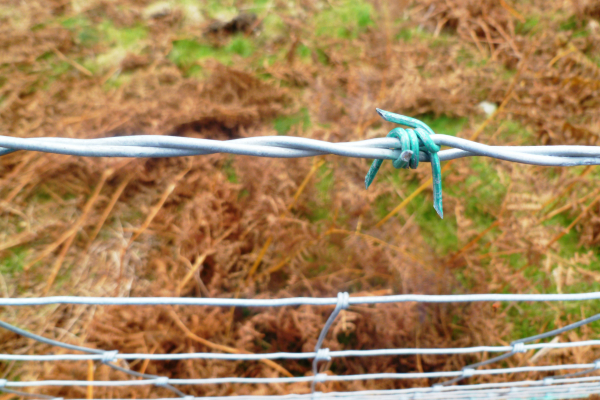
_600_400_s_c1_c_c.JPG)
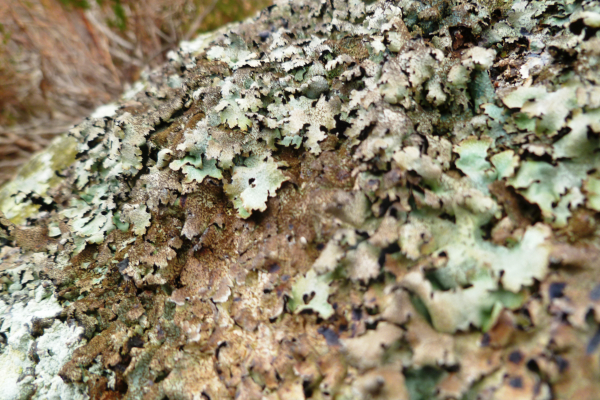
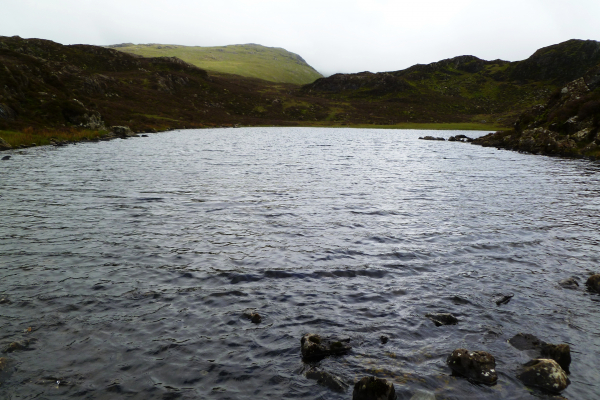
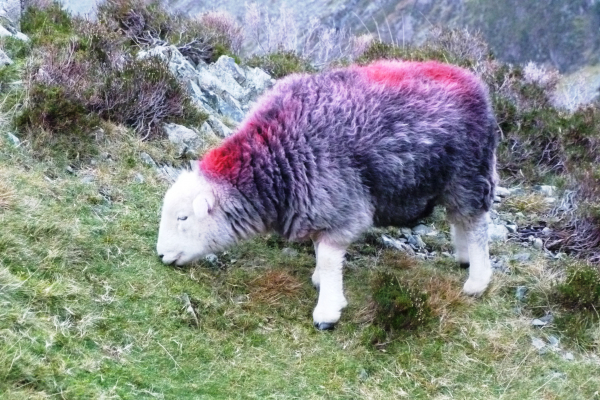
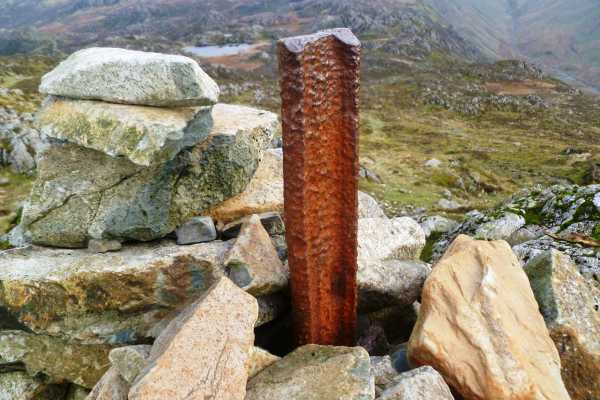
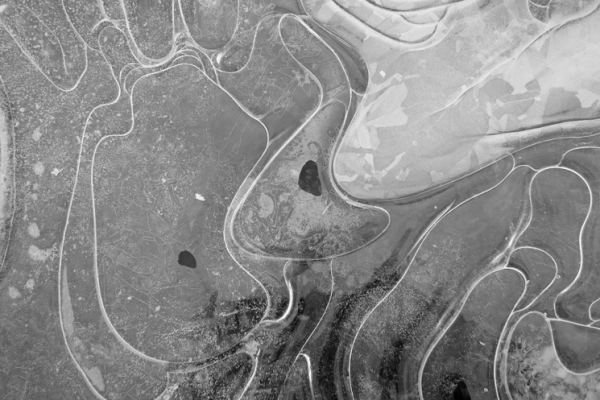
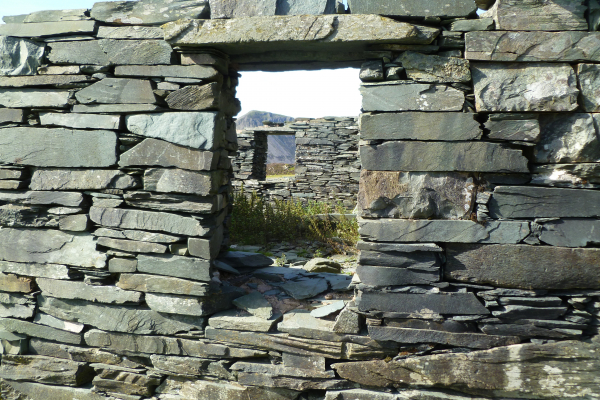
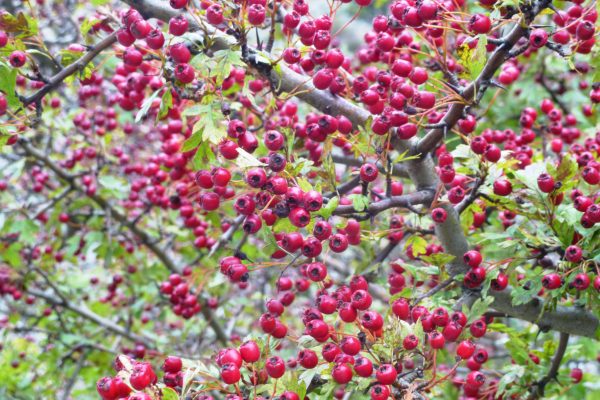
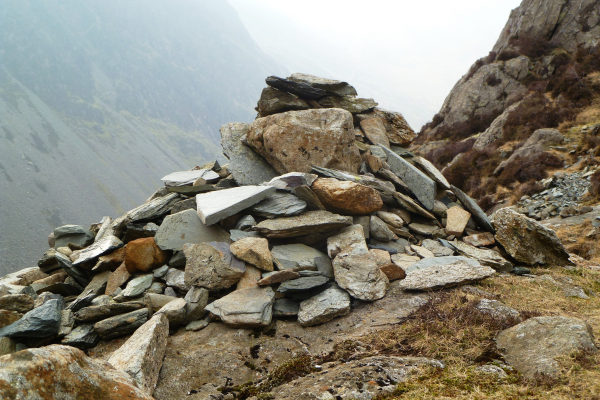
_600_400_s_c1_c_c.JPG)
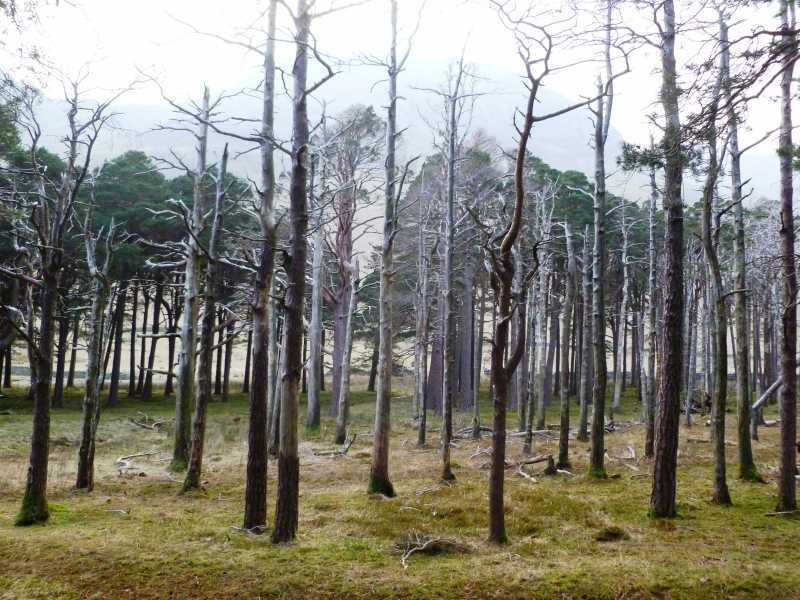
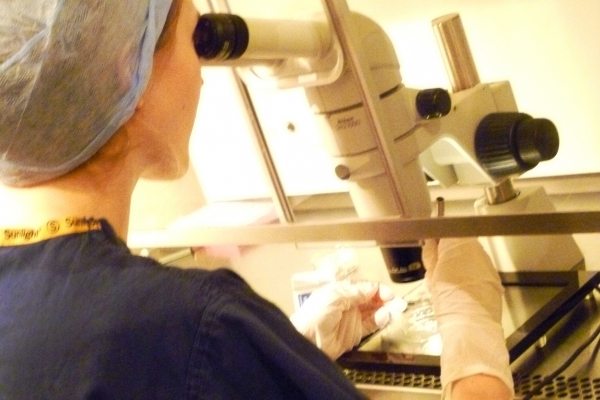
_600_400_s_c1_c_c.JPG)
_600_400_s_c1_c_c.JPG)
_600_400_s_c1_c_c.JPG)
_600_400_s_c1_c_c.JPG)
_600_400_s_c1_c_c.JPG)
_600_400_s_c1_c_c.JPG)
_600_400_s_c1_c_c.JPG)
_600_400_s_c1_c_c.JPG)
_800_600_s_c1_c_c.JPG)
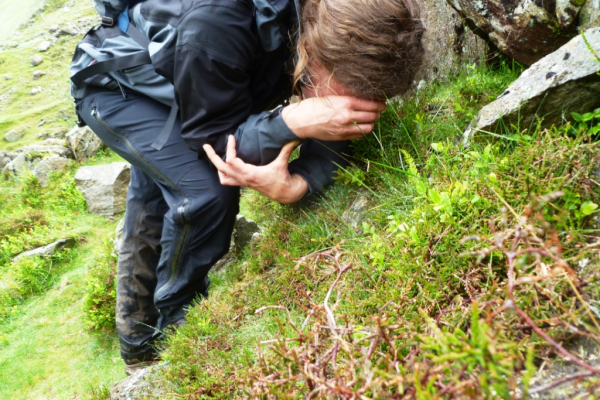
_600_400_s_c1_c_c.JPG)
_600_400_s_c1_c_c.JPG)
_600_400_s_c1_c_c.JPG)
_600_400_s_c1_c_c.JPG)
_600_400_s_c1_c_c.JPG)
_600_400_s_c1_c_c.JPG)
_600_400_s_c1_c_c.JPG)
_600_400_s_c1_c_c.JPG)
_600_400_s_c1_c_c.JPG)
_600_400_s_c1_c_c.JPG)
_600_400_s_c1_c_c.JPG)

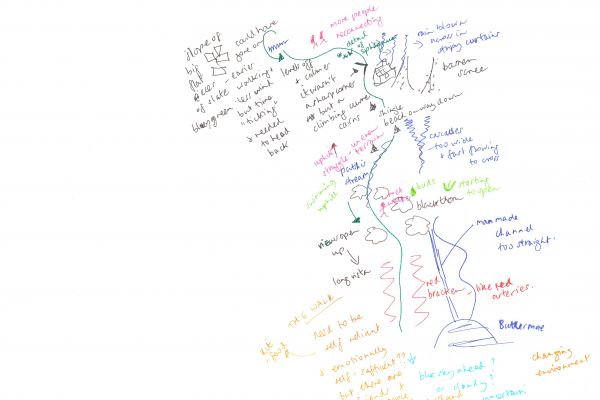
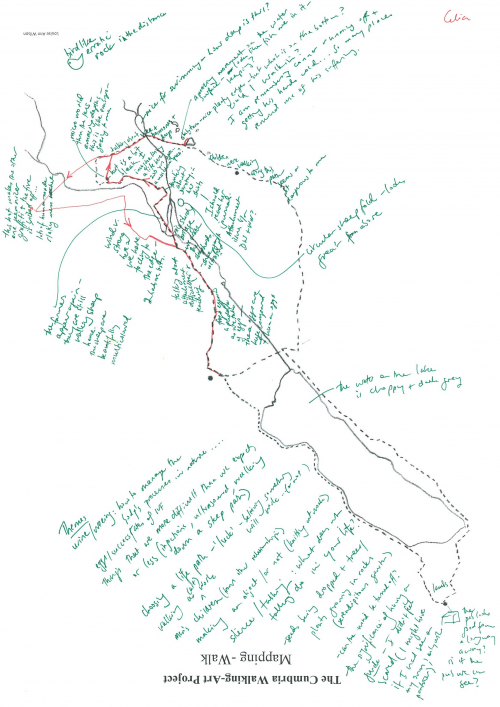

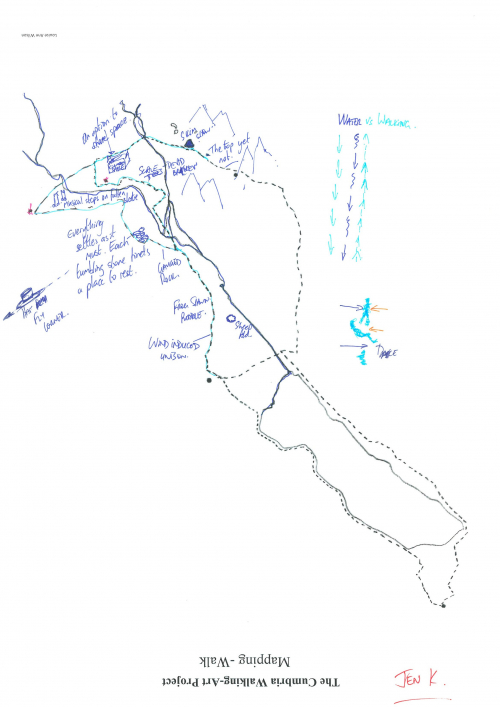
_800_600_s_c1_c_c.JPG)
